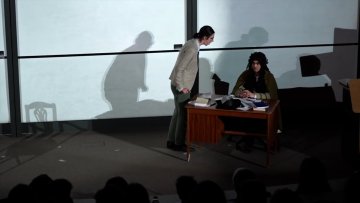Fermat's Last Tango, written in 2000 by Joanne Sydney Lessner and Joshua Rosenblum, tells the story, in words and music, of a 300 hundred-year-old mathematical mystery and the man who spent seven years trying to solve it.
This version was performed in early March 2023 by Oxford Mathematics students and fellow students from across the University. The venue was a lecture theatre in the Andrew Wiles Building, home to Oxford Mathematics and named after the mathematician who is the subject of the story.
Bootstrapping surface defects in the 6d N=(2,0) theories
Abstract
6d N=(2,0) superconformal field theories have natural surface operators similar in many ways to Wilson lines in gauge theories. In this talk, I will discuss how they can be studied using conformal bootstrap techniques, including connection to W-algebras and the so-called inversion formula, focusing on the limit of large central charge.
Non-ordinary conjectures in Iwasawa Theory
Abstract
The Iwasawa main conjecture, first developed in the 1960s and later generalised to a modular forms setting, is the prediction that algebraic and analytic constructions of a p-adic L-function agree. This has applications towards the Birch—Swinnerton-Dyer conjecture and many similar problems. This was proved by Kato (’04) and Skinner—Urban (’06) for ordinary modular forms. Progress in the non-ordinary setting is much more recent, requiring tools from p-adic Hodge theory and rigid analytic geometry. I aim to give an overview of this and discuss a new approach in the setting of unitary groups where even more things go wrong.
The first cohomology of submodule-subalgebras of the Witt algebra
Abstract
The study of cohomology of infinite-dimensional Lie algebras was started by Gel'fand and Fuchs in the late 1960s. Since then, significant progress has been made, mainly focusing on the Witt algebra (the Lie algebra of vector fields on the punctured affine line) and some of its subalgebras. In this talk, I will explain the basics of Lie algebra cohomology and sketch the computation of the first cohomology group of certain subalgebras of the Witt algebra known as submodule-subalgebras. Interestingly, these cohomology groups are, in some sense, controlled by the cohomology of the Witt algebra. This can be explained by the fact that the Witt algebra can be abstractly reconstructed from any of its submodule-subalgebras, which can be described as a universal property satisfied by the Witt algebra.


